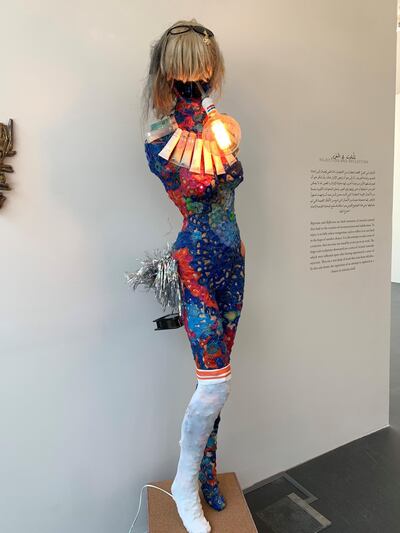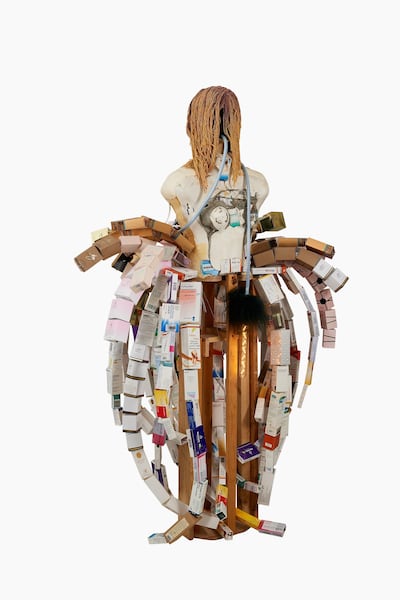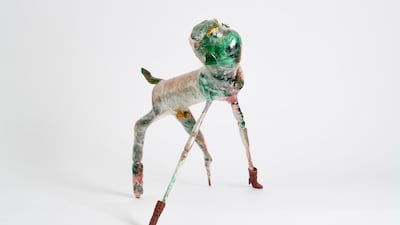Wearing a wig held back by a broken pair of sunglasses and a necklace lined with tubes of lotion, a mannequin gawks down at visitors to Warehouse421. Its face has been hollowed out to make room for a large, bulbous Edison-style light bulb. Its body is covered with small circles of red and blue paint. A pom-pom is fastened as a tail, the silver strips of plastic fluttering in the air blowing from a fan that is fixed at its thigh.
It is a strange, otherworldly sculpture, and like the rest of Hashel Al Lamki's works at the gallery, it doesn't immediately make sense. The mannequin beside it wears a dress made of empty pill packaging. It seems Al Lamki is trying to draw a metaphor about society's dependency on pharmaceuticals.
He gives objects such as empty Vimto bottles and medication boxes another meaning.

The key to understanding his work may be in the title of Al Lamki's first major solo exhibition, The Cup and The Saucer, which opened this week. The show's curator, Munira Al Sayegh, says the crockery is a metaphor for two objects that are created for one another, and which only exist separately when they are pulled away from each other by another factor.
You might think "this is as self-indulgent as art can get", as though someone had made a bulk of work and scrambled to find a justification for it, loosely tying them together under the vague umbrella of a metaphor. But there's more to it.
The show, which is divided into nine parts, explores diverse themes including "birth and death" and "rejection and reflection". It is the culmination of a two-year collaboration between Al Sayegh and Al Lamki, one of the founders of Bait 15, a studio and gallery in Abu Dhabi.

The first artwork on view at the exhibition is an explosion of gaudy ties billowing from underneath a block of concrete, on top of which a long, wilting stem of poker chips forms. It looks like a house plant made of rubbish. The approach is echoed in another piece further on, in an artwork of stacked pistachios balanced on top of an old pearlescent vase.
As a viewer, you don't know whether you are being mocked or made privy to a joke.
Al Lamki is doing his part to usurp the place of craft in art, giving precedent and priority to his concepts instead. The idea, he says, is to remove any hindrance from the flow of ideas.
"Munira and I would brainstorm during our ritualistic Monday meetings. We kept a fact sheet and would jot down information on whatever was inspiring us that day, from facts about Jebel Hafeet to penguins and bananas," he says.
Al Lamki goes to Abu Dhabi looking for material to work with, from malls and souqs to old buildings around the city's Tourist Club area that are scheduled for demolition. He salvages old vases, discarded clothes and other material destined for the junkyard and gives them second life.
"It's not dumpster diving," he says. "It's just going about and finding material to work with, particularly those no longer in use by the standards we live by. That's always been my process. I don't stick to a single medium, doing everything from sculpture to video. With this exhibition, I found I had more freedom. To work with the same approach, but on a much larger scale."
This scale, however, may be detrimental to the wider scope of the exhibition's statement. Some the works seem to lack focus and, while interesting to look at, do not add to the overarching artistic narrative.
But then comes a room housing a collection of 50 paintings, huddled frame to frame. The space probably holds the best work of the show, and includes paintings of a golf course, a petrol station, the interior of Louvre Abu Dhabi, the fruit section of a supermarket and the night view from the top of Jebel Hafeet. The paintings have been executed with an idiosyncratic finesse. The vibrancy of their colours is arresting. The landscapes and subjects are familiar to a UAE resident, but Al Lamki's choice of what to leave out of focus and what to detail makes you see them again, in a new light.
One of the most impressive pieces is a mural depicting a desert landscape on the left and a golf course on the right. A polar bear with a muzzle tears a piece of meat from the carcass of its kill. In the background is a hazy view of a waddle of penguins. The painting is surreal. But just when you thought you understood what the exhibition is about, this picture throws your assumptions into the wind. Whether this is a good or bad thing is for you to decide.
In one piece, called Screen Savers, a video installation shows fractal patterns and a woman with balloons and a blank expression. The video is subtitled with facts about Al Ain, where Al Lamki is from, and Jebel Hafeet. They detail that Jebel Hafeet is steeper on its east side, that the area was separated from Africa about 25 million years ago and that it moves north about five centimetres every year.
They are facts you'd expect to find on Wikipedia, yet there they are, appearing on the screen like lyric cues in a karaoke video. That being said, The Cup and The Saucer is a journey into a resourceful artistic practice and an invitation into Al Lamki's imagination. The more patient observers are likely to find lots to glean from his pieces. If anything, the artist takes you on a journey that makes you question everything you see.
The Cup and The Saucer is at Warehouse421, Mina Zayed, Abu Dhabi, until Sunday, May 17



